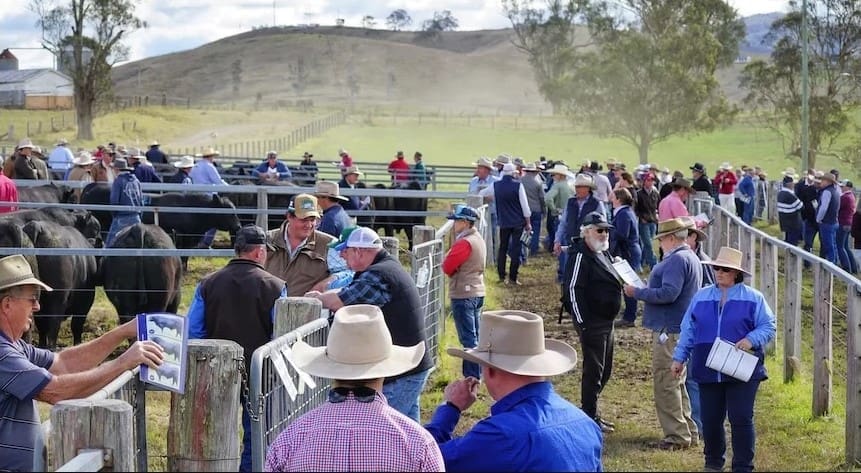
THERE are many factors that influence the outcome of a bull sale. It is often tempting to try to reduce these down to one of two common themes.
The most frequently cited examples include the impact of the season and the prices being received in the broader cattle market. These certainly play a significant role in shaping outcome of any bull sale, not least for the influence on producers overall optimism and outlook.
However, there are also other factors at play that are more subtle but can equally determine a sale’s success.
One factor that has been the subject of interesting recent research in the United States has been the influence of ‘Optimism Bias’ among bull breeders and purchasers during sales.
In simple terms Optimism Bias is the tendency people have to overestimate the likelihood of positive outcomes, and under-estimate the likelihood of negative outcomes. The term is well-known in clinical and business circles, often seen in trends such as the stock market.
Examples of this bias can be seen playing out at stud cattle auctions. Vendors may believe a bull may be worth more than similar bulls, while at the same time buyers may believe a bull will perfume better than its performance data suggests because ‘they have a good eye for cattle.”
A recent peer-reviewed study published in the Journal of Agricultural and Applied Economics by Seth Ingram (et al) “Predicting Seedstock Bull Prices: Does Information Matter?”, conducted research with 164 cattle producers from Tennessee and Alabama. The producers were asked to predict the sale prices of 18 real bulls (Angus, Charolais, and Simmental), using only videos and EPD profile data.
The participants were randomly assigned a role as either a breeder or a buyer to reflect the way that person may think. To motivate the participants to make realistic decisions, the study paid those who made predictions that were within $500 of the actual sale price.
The results of the research found those who identified as bull sellers consistently overestimated bull prices compared to buyers. This pattern of overvaluation persisted even when education, experience, and confidence levels were accounted for.
The researchers concluded that optimism bias, the natural tendency of sellers to believe their animals are worth more, was a significant factor in price mis-alignment.
Many of the same dynamics – emotional investment, production system familiarity and market expectation – play out across our seasonal bull selling cycles
These findings, while drawn from a US context, are highly relevant to Australian seedstock producers. Many of the same dynamics, emotional investment, production system familiarity, and market expectation, play out across our seasonal bull selling cycles, particularly in the lead-up to spring sales.
Emotional investment
Several reasons contribute to this belief. Bull breeders are often emotionally and financially invested in the bulls they offer. They may focus on standout traits or the best-case scenario for that animal and expect the market to share their valuation.
This can be described as the ‘endowment effect’, where people place higher value on something simply because they own it.
Breed familiarity
The study also uncovered additional trends. Producers with a strong familiarity or affinity for a particular breed, were less accurate in their price predictions. Confidence in one’s ability to assess traits, pedigrees, or bloodlines was negatively correlated with prediction accuracy. In other words, the more confident someone was, the less accurate their predictions tended to be.
Reputation
Another observation related to reputation. Sellers from well-known or respected stud prefixes tended to expect price premiums based on their name alone, regardless of the individual merit of the bull. The researchers noted that this can lead to overpricing of early sale lots and disappointment when market response doesn’t meet expectations.
In recognising these tendencies, particularly emotional attachment, overconfidence, and reliance on reputation, breeders can adjust their sale preparation to minimise the risk of experiencing a disappointing sale.
Practical ways to address these risks range from seeking independent feedback on draft quality, benchmarking sale bulls against breed percentiles rather than previous sale results and reviewing sale data from other programs with similar genetics.
Having someone else review sale lots objectively, whether a trusted advisor, agent, or fellow breeder, can help identify where expectations may need recalibrating. Being transparent about strengths and limitations, and backing bulls with data rather than assumption, also builds buyer confidence.
Ultimately, it’s about shifting from a mindset of what a bull should bring, to what the market is willing to pay, based on merit and value.
Confidence overriding evidence
From the buyer’s perspective, this US research highlights how easy it can be to let confidence override evidence.
Many buyers take pride in their ability to “pick a good one” based on visual appraisal or gut instinct, particularly if they’ve been selecting bulls for many years. However the study found that higher confidence among buyers was associated with lower accuracy in price prediction.
This suggests that over-reliance on visual traits or breed familiarity can lead to inflated expectations, and in some cases, overpaying for bulls that don’t deliver the expected returns.
Structured information
The research demonstrated that what did help buyers make more accurate judgments on value was the use of structured information, particularly percentile rankings and genomically enhanced EPDs (the equivalent of Australia’s EBVs).
These tools were found to offer context and clarity, especially when comparing bulls across different sale drafts or catalogues.
Buyers who made use of this data were less influenced by reputation or sale order and were more likely to identify bulls with genuine genetic merit. In essence, they approached the sale with clearer benchmarks and made better-aligned investments as a result.
The broader message for buyers is not to dismiss their own experience, but to complement it with data.
Sale-day decisions are often made quickly and under pressure. Therefore, it is essential buyers make time ahead of a sale to review EBVs, understand percentile ranks, and then set realistic expectations.
Recognising the potential for bias, especially when confidence around a breed is high, may help keep decisions grounded, repeatable, and ultimately more profitable in the long term.

Alastair Rayner
Alastair Rayner is Principal of RaynerAg and an Extension & Engagement Consultant with the Agricultural Business Research Institute (ABRI). He has over 28 years’ experience advising beef producers and graziers across Australia. Alastair can be contacted here or through his website: www.raynerag.com.au

HAVE YOUR SAY